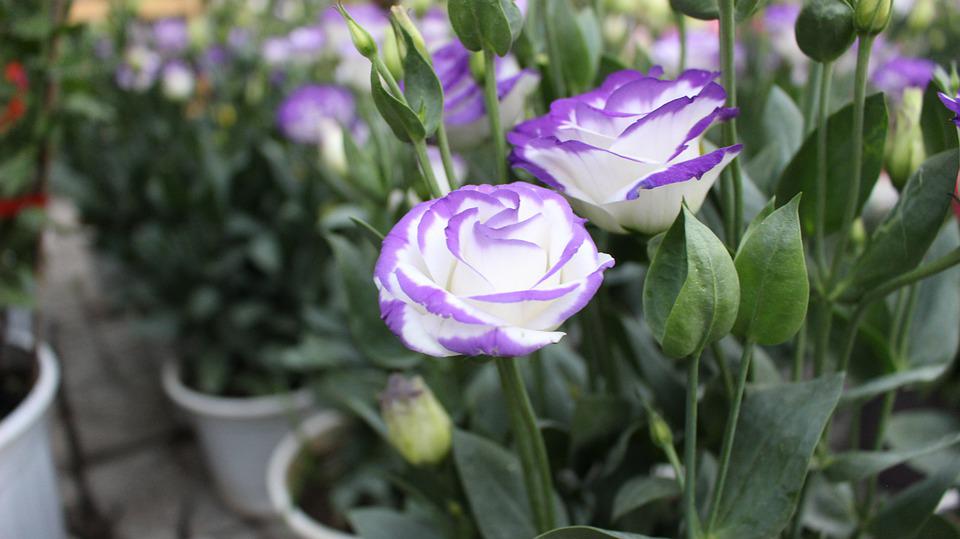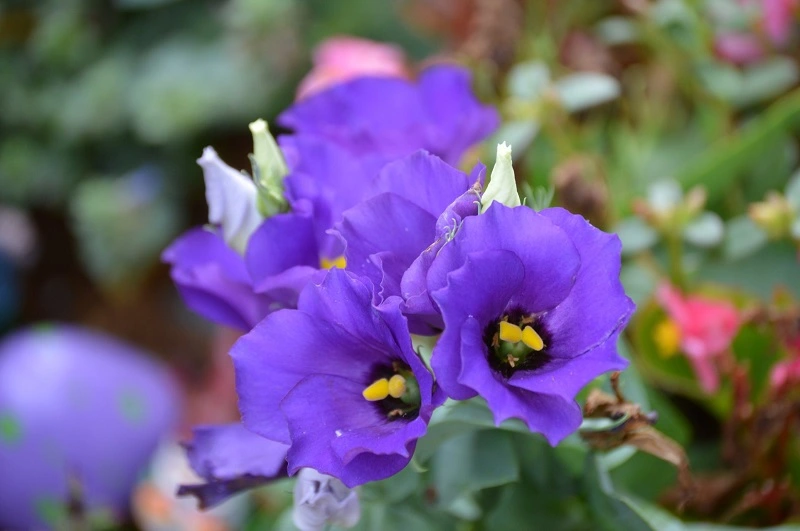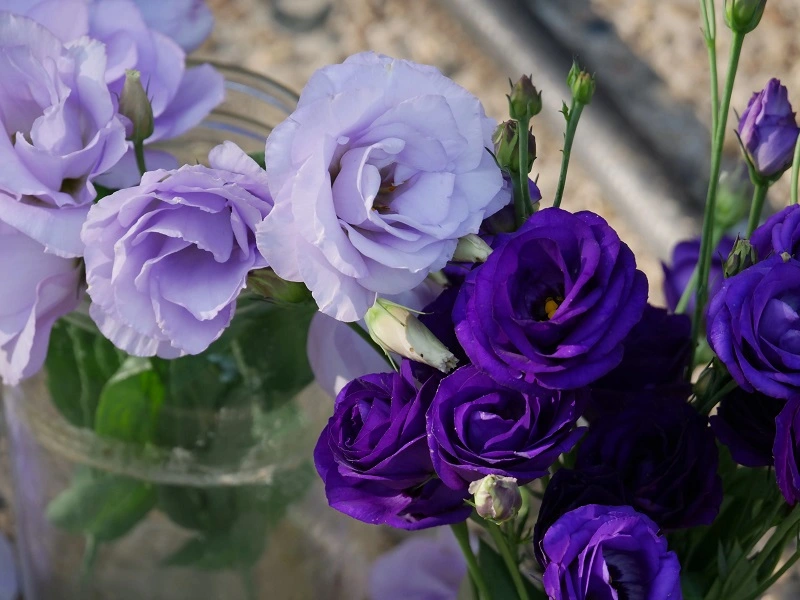Lisianthus Pflege - Lernen Sie, Wie Man Schillernde Eustoma Blumen Wachsen Lässt
Die Lisianthus ist eine der häufigsten Gartenpflanzen. Obwohl sie nicht hoch wächst, hat sie beeindruckende, glockenförmige Blüten. Sie ist nicht schwer zu kultivieren, benötigt aber einen sonnigen Standort und einen mäßig feuchten Boden. Sie fragen sich, was Sie sonst noch über diese Pflanze wissen sollten? Hier erfahren Sie, wie Sie die besten Ergebnisse erzielen können.

Lisianthus - was für eine Pflanze ist das und woher kommt sie?
Lisianthus, auch bekannt als Texas bluebell (Eustoma grandiflorum) ist eine einjährige Pflanze, die in Nordamerika und Mexiko heimisch ist. In den südlichen Regionen wird sie oft Prairie-Enzian genannt.
Lisianthus ist keine hohe Pflanze. Typischerweise wird sie bis zu 50-60 cm hoch. Was ihn von anderen Pflanzen im Hausgarten unterscheidet, sind seine Blüten. Sie sind glockenförmig und erreichen eine Länge von bis zu 15 cm (5,91 in). Sie sehen sehr majestätisch aus.

Was sind die besten Bedingungen für Lisianthus-Pflanzen?
Wenn Sie Lisianthus anbauen möchten, müssen Sie zunächst einen geeigneten Boden auswählen, in dem die Pflanze wachsen kann. Ein fruchtbarer Boden mit einem gewissen Lehmanteil, der aber dennoch durchlässig ist, ist ideal für Pflanzen wie Eustoma.
Lisianthus ist eine Blume, die helle Standorte liebt. Achten Sie darauf, dass der Platz, an dem sie wächst, nicht von Ziersträuchern Gartensträuchern verdeckt wird. Alternativ können Sie sie auch im Halbschatten pflanzen.
Lisianthus erfordert regelmäßiges Gießen und Füttern. Dadurch erreichen Sie eine schöne Blüte und die Pflanze ist weniger anfällig für verschiedene Krankheiten.
Wie pflanzt man Lisianthus um? Der Prärie-Enzian muss nicht umgepflanzt werden, da er einjährig ist. Das bedeutet, dass er nur einmal blüht. Danach muss die Pflanze aus dem Garten oder aus dem Haus entfernt werden, je nach Kulturform.

Topf-Lisianthus - die beliebteste Form
Abhängig von der Region kann Lisianthus auf zwei Arten angebaut werden. Eine davon ist das Einpflanzen der Pflanze in die Erde, z.B. in Blumenbeete. Eine andere - weitaus beliebtere - Methode ist die Kultivierung von Lisianthus als Topfpflanze.
Bei der letztgenannten Methode wird die Pflanze im Haus oder - wenn es die Temperatur zulässt - draußen im Garten, auf dem Balkon oder der Terrasse gehalten, je nachdem, wie viel Platz zur Verfügung steht.

Lisianthus - bemerkenswerte Kultivare
Es gibt verschiedene Sorten von Lisianthus. So kann jeder Gärtner die perfekte Sorte für sich finden. Besonders beliebt sind die Zwergvarianten. Aber auch mehrfarbige Exemplare sehen sehr interessant aus.
Zu den am häufigsten gepflückten Lisianthus-Sorten für Haus und Garten gehören:
- lisianthus ‘Carmen’
- lisianthus ‘Super Magic
- Lisianthus ‘Corelli
- lisianthus ‘Rosanne’
- lisianthus ‘Russell
- lisianthus ‘Echo
- Lisianthus ‘Alissa
- lisianthus ‘Pics’
- lisianthus ‘Königin

Lisianthus - nicht nur eine Gartendekoration
Die Lisianthus ist nicht nur beliebt, weil sie in Gärten, auf Balkonen und Terrassen schön aussieht. Sie ist auch ein häufiges Element von Blumensträußen, vor allem bei Hochzeiten. Sie ist sehr universell und ihr Aussehen passt zu fast jedem Stil, der für das Fest geplant ist.
Ist die Lisianthus anfällig für Krankheiten und Schädlinge?
Lisianthus ist nicht sehr empfindlich, obwohl sie für bestimmte Viruskrankheiten anfällig sein kann. Wenn Sie die Erde zu stark bewässern, kann auch Grauschimmel auftreten.
Verschiedene Arten von Schädlingen sind eine viel größere Bedrohung für die Eustoma-Pflanze. Zu den wichtigsten gehören:
Eine sorgfältige Beobachtung der Pflanze ist sehr wichtig. Wenn Ihre Lisianthus schwach aussieht, wurde sie wahrscheinlich befallen. Wenn dies der Fall ist, sind Hausmittel einen Versuch wert. Aber wenn sie nicht funktionieren, müssen Sie spezielle chemische Sprays verwenden.

📍 Lisianthus im Topf - wie pflegt man die Pflanze?
Die Pflege von Lisianthus im Kübel ist nicht schwierig. Wählen Sie zunächst die richtige Erde und den richtigen Standort. Die Blumenerde sollte reichhaltig sein, und der Topf sollte in der Sonne oder im Halbschatten stehen. Gießen Sie die Pflanze regelmäßig und achten Sie darauf, dass die Erde immer mäßig feucht ist. Düngen Sie Ihre Lisianthus alle 2 Wochen.
📍 Warum verwelkt meine Lisianthus?
Es gibt viele mögliche Gründe für das Verwelken einer Lisianthus. Typisch sind Pilzkrankheiten. Beobachten Sie die Pflanze daher genau. Ansonsten könnte der Boden zu feucht oder zu trocken sein. Eine verwelkende Lisianthus kann auch bedeuten, dass sie Nährstoffe braucht.
📍 Wie pflegt man Lisianthus im Garten?
Die Pflege von Lisianthusblumen, die direkt in der Erde wachsen, sieht genauso aus wie die Pflege von Topfpflanzen. Gute Erde und ein guter Standort sind das A und O. Bei heißem Wetter muss täglich gegossen werden. Vergessen Sie nicht, einen Dünger für blühende Pflanzen zu verwenden.
📍 Wann blüht die Lisianthus?
Lisianthus ist eine Pflanze, die in den letzten Wochen des Frühlings und zu Beginn des Sommers blüht. Vieles hängt von den Bedingungen und der Temperatur ab, die sie hat. Sie ist einjährig, kann also nach der Blüte entfernt werden.
Empfohlene Artikel




